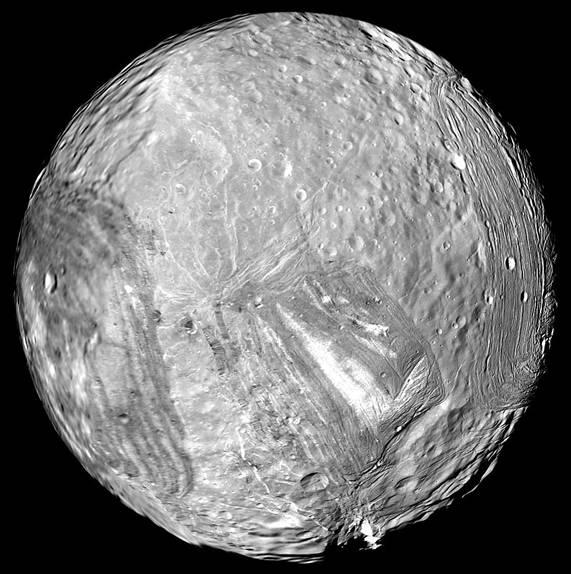

Recent research may suggest that Europa is going to be a hard landing for any spacecraft, what with 50 foot ice spikes potentially jutting out at its equator. But there’s one place in the solar system that can put its treacherous terrain to shame.
You afraid of 50 foot ice spikes? Just wait until you encounter an 11 mile high drop.
The place in question is a partially-charted, tiny moon of Uranus called Miranda. It’s about the same size as the famous ocean moon Enceladus, Saturn’s geyser-filled little scamp, but these worlds have vastly different histories. While Enceladus has a rich ocean that tantalizes astrobiologists Miranda is a broken world of deep canyons, high icy peaks, and a terrain unlike any other round body in the solar system.
“Some of Miranda’s geology is unique to Miranda,” Carly Howett, Section Manager of the Outer Solar System Department at the Southwest Research Institute says. “It’s a very strange system and a very difficult place to land.”
Imagine a deeply fragmented terrain that looks like, as Howett says, a jigsaw puzzle where someone was “scrambling the pieces and saying ‘ahh that’s good enough.'” The most prominent feature is a cliff 11 miles high called Verona Rupes. The peak is so high and the gravity is so low that if you jumped off it, you would fall for 12 minutes.

It’s also dotted with a few strange features called coronae. They’re more than 100 miles long and 12 miles deep, albeit without the steep drop-off of Verona Rupes. They’re seemingly younger than the rest of the surface, without any craters, unlike the more “normal” parts of the surface, which are dotted with impact sites of various sizes.
In other words: good luck landing here. We’ve only seen Miranda up close once, in 1986, when Voyager 2 photographed roughly half of the moon as it sped past. Those cameras didn’t have the resolution of imagers on modern spacecraft—New Horizons managed to snap pictures of Pluto at a resolution of 260 feet per pixel in 2015—so, many smaller features on Miranda’s surface are still a mystery. It’s possible that a good landing place does exist, but “on the hundreds of meters scale, landing on Miranda would certainly be a daunting task,” Howett says.
Origin Story
So how did such a world come to be? It may have once been a lot like Enceladus, with an icy shell covering an internal ocean, kept warm by the constant tug of Uranus’s gravity, which is strong enough to tug on Miranda’s interior as it orbits. But as time went on and Miranda receded into a more distant orbit, it came to look like a more extreme, smaller version of another solar system moon: Charon, locked in a strange orbit with Pluto.
Just like Miranda, Charon likely once had an ocean. Researchers think that when Charon’s ocean froze, it pushed outward, breaking through the outer icy crust and creating a massive series of cracks across the equator. Something similar probably happened to Miranda, but because Miranda is 60 percent smaller than Charon, the extrusion of ice from below was more extreme. The process left Miranda looking as though the world was shattered apart and clumsily put together again. (The jumble was so pronounced that researchers used to believe that some massive object had slammed into the moon and rearranged it completely, but that idea has fallen out of favor.)
We know all of this from seeing only the southern hemisphere of the moon. Uranus and its moons are tilted on their sides with respect to the rest of the planets. This means that Voyager 2 saw only the bottom halves of the five largest satellites as it flew by. What the equatorial region looks like is a complete mystery, let alone the northern hemisphere.
That could be changed with a dedicated mission to Uranus. There is one in the very, very early planning stages—so early that it hasn’t been given an official greenlight or a budget by NASA. Put together by Mark Hoftstader, Amy Simon, and New Horizons lead Alan Stern, the proposal calls for another, more detailed flyby of Uranus and an orbiter for Neptune, whose moon Triton is a little more high priority, science-wise, than any of Uranus’ 27 moons. Triton is particularly interesting to researchers because Neptune’s gravity dragged it out of the Kuiper Belt (the icy region where Pluto lives) and into orbit. Triton, unlike Miranda, is also geologically active, with erupting geysers and a nitrogen atmosphere.
“Uranus and Neptune are both ice giants, but their icy satellites have very different systems,” Howett says.
Even if this mission happens, and Miranda is included on the final list of science priorities, it may not provide as many answers as we’d like about how Miranda came to be. Howett compares it to the Cassini mission at Saturn: after 13 years in the system, we were left with more questions than answers, and follow-up missions to the ringed planet are already on the docket.
“The more you understand, the more you realize you don’t know,” Howett says. “Everyone came around wanting more.”
That could mean that revealing a few of the moon’s secrets could open up mysteries running deeper than any feature on Miranda—just don’t expect us to get a lander there anytime in the coming decades.
